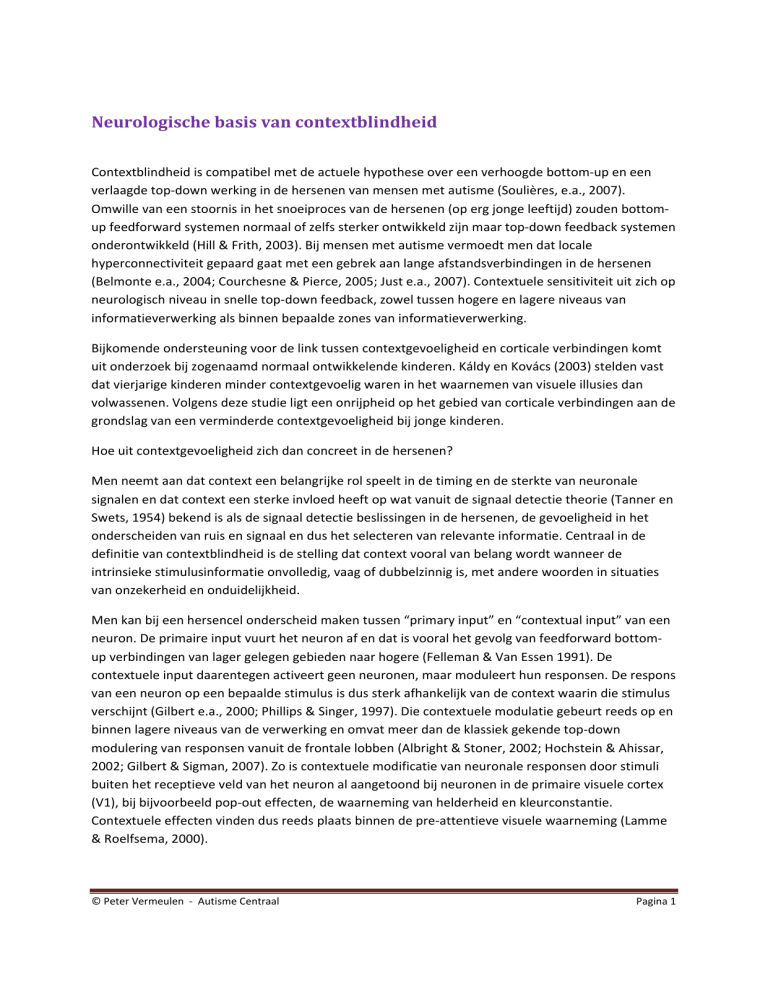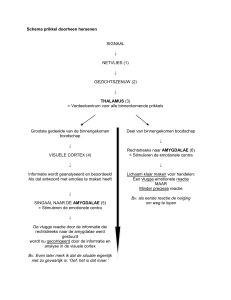
Neurologische basis van contextblindheid Contextblindheid is compatibel met de actuele hypothese over een verhoogde bottom‐up en een verlaagde top‐down werking in de hersenen van mensen met autisme (Soulières, e.a., 2007). Omwille van een stoornis in het snoeiproces van de hersenen (op erg jonge leeftijd) zouden bottom‐
up feedforward systemen normaal of zelfs sterker ontwikkeld zijn maar top‐down feedback systemen onderontwikkeld (Hill & Frith, 2003). Bij mensen met autisme vermoedt men dat locale hyperconnectiviteit gepaard gaat met een gebrek aan lange afstandsverbindingen in de hersenen (Belmonte e.a., 2004; Courchesne & Pierce, 2005; Just e.a., 2007). Contextuele sensitiviteit uit zich op neurologisch niveau in snelle top‐down feedback, zowel tussen hogere en lagere niveaus van informatieverwerking als binnen bepaalde zones van informatieverwerking. Bijkomende ondersteuning voor de link tussen contextgevoeligheid en corticale verbindingen komt uit onderzoek bij zogenaamd normaal ontwikkelende kinderen. Káldy en Kovács (2003) stelden vast dat vierjarige kinderen minder contextgevoelig waren in het waarnemen van visuele illusies dan volwassenen. Volgens deze studie ligt een onrijpheid op het gebied van corticale verbindingen aan de grondslag van een verminderde contextgevoeligheid bij jonge kinderen. Hoe uit contextgevoeligheid zich dan concreet in de hersenen? Men neemt aan dat context een belangrijke rol speelt in de timing en de sterkte van neuronale signalen en dat context een sterke invloed heeft op wat vanuit de signaal detectie theorie (Tanner en Swets, 1954) bekend is als de signaal detectie beslissingen in de hersenen, de gevoeligheid in het onderscheiden van ruis en signaal en dus het selecteren van relevante informatie. Centraal in de definitie van contextblindheid is de stelling dat context vooral van belang wordt wanneer de intrinsieke stimulusinformatie onvolledig, vaag of dubbelzinnig is, met andere woorden in situaties van onzekerheid en onduidelijkheid. Men kan bij een hersencel onderscheid maken tussen “primary input” en “contextual input” van een neuron. De primaire input vuurt het neuron af en dat is vooral het gevolg van feedforward bottom‐
up verbindingen van lager gelegen gebieden naar hogere (Felleman & Van Essen 1991). De contextuele input daarentegen activeert geen neuronen, maar moduleert hun responsen. De respons van een neuron op een bepaalde stimulus is dus sterk afhankelijk van de context waarin die stimulus verschijnt (Gilbert e.a., 2000; Phillips & Singer, 1997). Die contextuele modulatie gebeurt reeds op en binnen lagere niveaus van de verwerking en omvat meer dan de klassiek gekende top‐down modulering van responsen vanuit de frontale lobben (Albright & Stoner, 2002; Hochstein & Ahissar, 2002; Gilbert & Sigman, 2007). Zo is contextuele modificatie van neuronale responsen door stimuli buiten het receptieve veld van het neuron al aangetoond bij neuronen in de primaire visuele cortex (V1), bij bijvoorbeeld pop‐out effecten, de waarneming van helderheid en kleurconstantie. Contextuele effecten vinden dus reeds plaats binnen de pre‐attentieve visuele waarneming (Lamme & Roelfsema, 2000). © Peter Vermeulen ‐ Autisme Centraal Pagina 1 Maar context speelt natuurlijk vooral een rol door middel van lange‐afstands top‐down verbindingen. Contextuele beïnvloeding is onder meer aangetoond in top‐down connectiviteit vanuit de prefrontale en temporale gebieden (Helenius e.a., 1998; Barcelo & Knight, 2007; MacDonald e.a., 2005; Frith & Frith, 2003) Op neurofysiologisch niveau (event related potentials) is contextgevoeligheid in verband gebracht met de late P3b component (Kang e.a., 2005; Barcelo & Knight, 2007). De P3b is een reactie van de hersenen, ongeveer 300 milliseconden na het aanbieden van de stimulus. Verschillende studies hebben bij mensen met autisme een lagere amplitude getoond voor de P3b, voor zowel visuele als auditieve stimuli (zie o.a. Lincoln et al., 1993; Kemner et al, 1995; Townsend et al., 2001). Contextuele priming, zowel semantische als fonologische, uit zich eveneens in een reductie van de N400 amplitude (Helenius e.a., 1998; Perrin & Garcia‐Larrea, 2003; Bonte e.a., 2006). Bij mensen met autisme is een afwijkende N400 amplitude vastgesteld en in verband gebracht met een geringere contextgevoeligheid bij het verwerken van verbale informatie (Dun & Bates, 2005; Ring e.a., 2007; Braeutigam e.a., 2008). Referenties: Albright, T.D. & Stoner, G.R. (2002). Contextual influences on visual processing. Annual Reviews of Neuroscience, 25, 339‐379. Barcelo, F. & Knight, R.T. (2007) An information theoretical approach to contextual processing in the human brain: evidence from prefrontal lesions. Cerebral Cortex, 17, i51‐i60. Belmonte, M.K., Allen, G., Beckel‐Mitchener, A., Boulanger, L.M., Carper, R.A., & Webb, S.J. (2004). Autism and abnormal development of brain connectivity. Journal of Neuroscience, 24 (42), 9228‐9232. Bonte, M., Parviainen, T., Hytönen, K., & Salmelin, R. (2006). Time course of top‐down and bottom‐up influences on syllable processing in the auditory cortex. Cerebral Cortex, 16 (1), 115‐123. Braeutigam, S., Swithenby, S.J., & Bailey, A.J. (2008). Contextual integration the unusual way: a magnetoencephalographic study of responses to semantic violation in individuals with autism spectrum disorders. The European journal of neuroscience, 27 (4), 1026‐1036. Courchesne E. & Pierce, K. (2005). Why the frontal cortex in autism might be talking only to itself: local over‐
connectivity but long‐distance disconnection. Current Opinion in Neurobiology, 15 (2), 225‐230. Dunn, M.A. & Bates, J.C. (2005) Developmental change in neural processing of words by children with autism. Journal of Autism and Developmental Disorders, 35, 361–376. Felleman, D.J. & Van Essen, D.C. (1991). Distributed hierarchical processing in primate cerebral cortex. Cerebral Cortex, 1, 1‐47. Frith, U. & Frith, C.D. (2003). Development and neurophysiology of mentalising. Philosophical Transactions Series B, 1431, 459–474. Gilbert, C.D. & Sigman, M. (2007). Brain states: Top‐down influences in sensory processing. Neuron, 54 (5), 677‐
696 Gilbert, C., Ito, M., Kapadia, M., & Westheimer, G. (2000). Interactions between attention, context and learning in primary visual cortex. Vision Research, 40 (10‐12), 1217–1226. Helenius, P., Salmelin, R., Service, E., Connolly, J.F. (1998) Distinct time courses of word and context comprehension in the left temporal cortex. Brain, 121,1133‐1142. Hill, E.L., & Frith, U. (2003). Understanding autism: insights from mind and brain. Philosophical Transactions of the Royal Society ‐ Biological Sciences, 358 (1430), 281‐289. Hochstein, S. & Ahissar, M. (2002). View from the top: hierarchies and reverse hierarchies in the visual system. Neuron, 36 (5), 791‐804. © Peter Vermeulen ‐ Autisme Centraal Pagina 2 Just, M.A., Cherkassky, V.L., Keller, T.A., Kana, R.K., & Minshew, N.J. (2007). Functional and anatomical cortical underconnectivity in autism: Evidence from an fMRI study of an executive function task and corpus callosum morphometry. Cerebral Cortex, 17 (4), 951‐961. Káldy, Z. & Kovács, I. (2003). Visual context integration is not fully developed in 4‐year‐old children. Perception, 32 (6), 657–666. Kang, K., Williams, L.M., Hermens, D., & Gordon, E. (2005). Neurophysiological markers of contextual processing: The relationship between P3b and gamma synchrony and their modulation by arousal, performance and individual differences. Cognitive Brain Research, 25, 472‐483. Kemner, C., Verbaten, M.N., Cuperus, J.M., Camfferman, G., & van Engeland, H. (1995) Auditory event‐related brain potentials in autistic children and three different control groups. Biological Psychiatry, 38 (3), 150‐
165. Lamme, V.A.F. & Roelfsema, P.R. (2000), The distinct modes of vision offered by feedforward and recurrent processing. Trends in Neurosciences, 23 (11), 571‐579. Lee, T. S. (2002). Top–down influence in early visual processing: A Bayesian perspective. Physiology and Behaviour, 77, 645–650. Lincoln, A.J., Courchesne, E., Harms, L., & Allen, M. (1993). Contextual probability evaluation in autistic, receptive developmental language disorder, and control children: event‐related brain potential evidence, Journal of Autism and Developmental Disorders, 23 (1), 37–58. MacDonald, A.W., Carter, C.S., Kerns, J.G., Ursu, S., Barch, D. M., Holmes, A.J., Stenger, V. A., & Cohen, J.D. (2005).Specificity of prefrontal dysfunction and context processing deficits to schizophrenia in never‐
medicated patients with first‐episode psychosis. American Journal of Psychiatry,162, 475‐484. Perrin, F. & Garcia‐Larrea, L. (2003). Modulation of the N400 potential during auditory phonological/semantic interaction. Cognitive Brain Research, 17, 36‐47. Phillips, W.A. & Singer, W. (1997). In search of common foundations for cortical computation. Behavioral and Brain Sciences, 20 (4), 657‐722 . Soulières, I., Mottron, L., Saumier, D., & Larochelle, S. (2007). Atypical Categorical Perception in Autism: Autonomy of Discrimination? Journal of Autism and Developmental Disorders, 37 (3), 481‐490. Tanner, W.P. & Swets, J.A. (1954). A decision‐making theory of visual detection. Psychological Review, 61 (6), 401‐409. Townsend, J., Westerfield, M., Leaver, E., Makeig, S., Jung, T.‐P., Pierce, K., & Courchesne, E. (2001). Event‐
related brain response abnormalities in autism: Evidence for impaired cerebello–frontal spatial attention networks. Cognitive Brain Research, 11, 127– 145. © Peter Vermeulen ‐ Autisme Centraal Pagina 3











